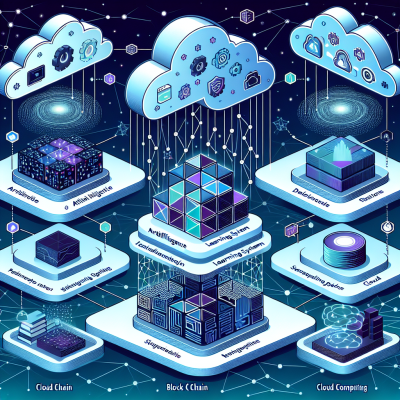An Interplay Between Metaverse, Artificial Intelligence, and Cybersecurity
The Metaverse is no longer just a concept from science fiction—it is a burgeoning reality where virtual environments blend seamlessly with our physical world. As this digital frontier expands, its integration with advanced technologies like Artificial Intelligence (AI) has unlocked remarkable opportunities, but it has also introduced significant cybersecurity challenges. In this blog post, we’ll delve into how the Metaverse leverages AI, the security threats arising from this synergy, and how we can address these challenges in a future-driven cyberspace.
What is the Metaverse?
At its core, the Metaverse refers to an interconnected virtual universe where users can interact in real-time through digital avatars. This immersive experience spans across diverse industries, including entertainment, education, healthcare, and e-commerce, and creates a new dimension for human interaction. Companies like Meta (formerly Facebook), NVIDIA, and Microsoft are heavily investing in building robust Metaverse platforms that promise to transform not just how we socialize but also how we work and do business.
AI: A Key Enabler in the Metaverse
One of the driving forces behind the functionality and scalability of the Metaverse is Artificial Intelligence. AI brings life to this digital sphere in a multitude of ways:
- Real-time Interactivity: AI-powered algorithms simulate responsive user environments that adapt to individual behavior.
- Content Creation: AI automates the creation of complex virtual spaces, avatars, and items, allowing for faster and more efficient development.
- Personalization: By analyzing user data, AI can customize experiences to match individual preferences, enhancing engagement and satisfaction.
- Translation Services: AI-driven translation tools enable global users to communicate effectively in different languages within the Metaverse.
While AI boosts innovation and engagement, its integration has also exposed the Metaverse to new vulnerabilities in the realm of cybersecurity. Let’s explore this issue further.
Cybersecurity Challenges in the Metaverse
The fusion of Metaverse systems with AI introduces a range of cybersecurity threats. These threats can disrupt the foundation of trust and engagement that the Metaverse aims to build. Below are some key cybersecurity concerns:
1. Identity Theft and Impersonation
In the Metaverse, users interact via avatars that often serve as their digital identities. Hackers are increasingly targeting these avatars to commit fraud, theft, and other malicious activities. Deepfake technology, bolstered by AI, exacerbates the problem by enabling cybercriminals to impersonate individuals with uncanny accuracy.
2. Data Privacy and Exploitation
AI thrives on data, and in the Metaverse, vast amounts of user information—ranging from behavioral patterns to biometric data—are collected. If not securely managed, this data becomes a goldmine for cybercriminals who can exploit it for identity fraud or sell it in the dark web.
3. AI-driven Cyberattacks
Ironically, the same AI systems enhancing the Metaverse are also being weaponized by attackers. AI algorithms are being used to bypass traditional security systems, launch sophisticated phishing attacks, and even manipulate virtual environments for nefarious purposes.
4. Security Loopholes in Hardware and Software
Devices like AR/VR headsets, haptic gloves, and controllers are essential for accessing the Metaverse. However, these devices can harbor potential vulnerabilities that hackers can exploit to gain unauthorized access to Metaverse platforms.
5. Smart Contracts and Financial Transactions
The Metaverse relies heavily on blockchain and smart contracts for financial transactions. While blockchain offers security advantages, improper implementation or coding errors in smart contracts can lead to financial losses or fraud.
Addressing Cybersecurity Threats in the Metaverse
As the Metaverse continues to evolve, so must our approach to safeguarding its users and systems. Below are some strategies to strengthen cybersecurity in this dynamic space:
- Advanced AI Cyber Defense: Leverage AI systems to detect and mitigate cyber threats in real-time, acting as a countermeasure against AI-driven attacks.
- Data Encryption: Employ robust encryption protocols to protect sensitive user information, ensuring data privacy and security.
- Decentralized Authentication: Implement blockchain-based identity verification systems to reduce the risk of identity theft and impersonation.
- User Education: Educate users on the importance of cybersecurity, such as recognizing phishing attempts and practicing good password hygiene.
- Regular System Audits: Conduct comprehensive security audits of hardware, software, and networks to identify and patch vulnerabilities.
The Role of Collaboration in Building a Secure Metaverse
Creating a safe Metaverse requires collaboration across industries, governments, and institutions. Policymakers should establish clear cybersecurity regulations specific to the Metaverse, while companies must prioritize transparency and accountability. Cybersecurity organizations and ethical hackers can also contribute by identifying vulnerabilities before bad actors exploit them.
Conclusion: Balancing Innovation and Security
The rise of the Metaverse marks a groundbreaking shift in how humans interact with technology and each other. While Artificial Intelligence plays a critical role in shaping this digital universe, its integration makes robust cybersecurity measures indispensable. Addressing security threats is not just about protecting users but also about ensuring the sustainable growth and widespread adoption of the Metaverse. As we continue to journey into this unexplored digital frontier, the need for balance between innovation and security cannot be overstated.
“`



Leave a Reply